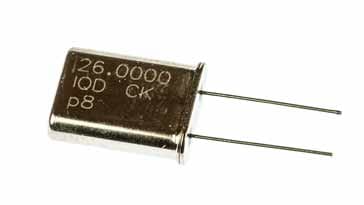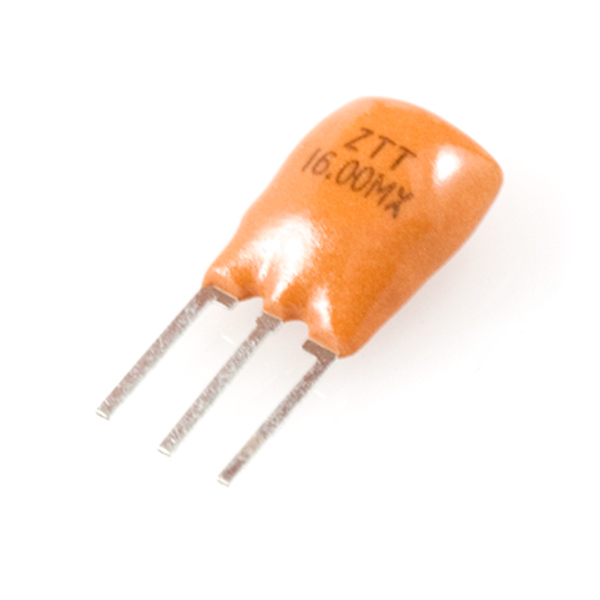Crystals, Resonators, and Oscillators
What are Crystals, Resonators, and Oscillators?
Crystals, resonators, and oscillators are devices that determine time or frequency in an electronic system [3].
Cost
It can be cheap to produce crystals [5] and it is often even cheaper to manufacture resonators [13]. When comparing the price of crystals and oscillators, the price of crystals appears to be very low; typical microelectromechanical (MEMS) oscillators are more expensive than crystals per piece. However, for many reasons, it is shortsighted to think that using crystals instead of oscillators will always be cheaper. The use of crystals can cause design issues and costly delays of a product's release date. Crystals require extra engineering work to fix these issues, meaning the cost to hire someone to do this work must be figured into the overall price. On the other hand, oscillators are flexible and very easy to design with so they do not require extra engineering work to start up properly. Generally speaking, the cost of using oscillators tends to be lower when the quantity of parts used is low, while the cost of using resonators tends to be lower when the quantity of parts used is high, although there are many other factors that must be considered when making this assumption. For instance, oscillators can drive multiple loads which means one oscillator can potentially do the job of multiple crystals [14].
Lifetime Expectancy
Crystal aging can be described as the long-term frequency change of a crystal over a period of years. Crystal aging occurs more quickly at higher temperatures [15][16]. Thus, when working with crystal oscillators, it may be a good idea to reduce the required temperature range of the oscillator so the crystal ages less rapidly [16].
Quartz can produce current without using much energy, which means it has low energy loss compared to other electronic currents. This allows quartz crystal oscillators to have long lifespans [6].
Crystals can have an indefinite shelf time depending on the conditions in which they are stored [17]. They should be stored in their original packaging [17], which is usually hermetically sealed to maintain the crystal's stability [7][15]. Most crystals can be stored in temperatures ranging from -40 to 85 degrees Celsius without experiencing material aging [15], although they are generally stored at temperatures closer to normal room temperature [15] (10 to 27 degrees Celsius [17]). It is also recommended that crystals be stored at a maximum of 30 to 40% relative humidity [17].
Crystals can age when impurities such as dust and other foreign substances stick to them or enter the package in which they are held [15][17]. For this reason, crystals should only be handled with tweezers and/or powder-free gloved hands [17].
Applications
Crystals
Crystals are used as frequency-determining devices in oscillators [4][5][12] because they are accurate and stable [5]. They can be used in a straightforward oscillator circuit to make a crystal oscillator (XO). This is a relatively inexpensive method of creating an oscillator and can be found in clock oscillators for microprocessors. Crystals are also used within filters to accept certain signals and reject others. Some filters can use up to six or even eight crystals to do this [5].
Resonators
Resonators operate similar to crystals. As such, resonators have very similar applications to crystals [8]. They can be used in the same oscillator circuits [13]. They are also used in signal filtering. Due to the less accurate nature of resonators, they are usually used in applications where timing is not as critical [18]. As they are more durable than crystals, they can also be used in applications where reliability is critical.
Oscillators
Oscillators have many applications as they are an easy way to generate a specific frequency [11]. There are two main types of oscillator: RC (resistor, capacitor) and LC (inductor, capacitor). RC circuits are used for low frequency applications while LC circuits are used for high frequency applications [11][19]. Crystal oscillators can act as RLC circuits which can be found in electronic watches, computers, and radio equipment [19]. Oscillators can also be found in audio and video systems, TVs, alarms, decorative lights, and more [11].
References
[1] “Timing Devices (MEMS Resonator / Crystal Unit / Ceramic Resonator / Oscillator),” Murata Manufacturing Co., Ltd. [Online]. Available: https://www.murata.com/en-eu/products/timingdevice. [Accessed: 26-Mar-2021].
[2] "100+ Electrical and Electronic Circuit Symbols," Electronics Hub, 23-Feb-2016. [Online]. Available: https://www.electronicshub.org/symbols/. [Accessed: 26-Mar-2021]
[3] “Crystals, Oscillators, Resonators,” DigiKey. [Online]. Available: https://www.digikey.ca/en/products/category/crystals-oscillators-resonators/12. [Accessed: 01-Mar-2021].
[4] “Quartz Crystal Oscillator,” ElectronicsTutorials, 21-Feb-2018. [Online]. Available: https://www.electronics-tutorials.ws/oscillator/crystal.html. [Accessed: 16-Feb-2021].
[5] “Quartz Crystal Resonator,” Electronics Notes. [Online]. Available: https://www.electronics-notes.com/articles/electronic_components/quartz-crystal-xtal/resonator-basics-tutorial.php. [Accessed: 26-Mar-2021].
[6] “Everything You Need to Know About the Quartz Crystal Oscillator,” QVS Tech. [Online]. Available: https://www.qvstech.com/everything-you-need-to-know-about-the-quartz-crystal-oscillator/. [Accessed: 26-Mar-2021].
[7] J. List, “Understanding The Quartz Crystal Resonator,” Hackaday, 17-Jan-2017. [Online]. Available: https://hackaday.com/2017/01/17/understanding-the-quartz-crystal-resonator/. [Accessed: 26-Mar-2021].
[8] "Resonators," Digikey. [Online]. Available: https://www.digikey.ca/en/products/filter/resonators/174. [Accessed: 26-Mar-2021].
[9] “LC Oscillator Tutorial and Tuned LC Oscillator Basics,” ElectronicsTutorials, 19-Feb-2018. [Online]. Available: https://www.electronics-tutorials.ws/oscillator/oscillators.html. [Accessed: 12-Feb-2021].
[10] "Ceramic Resonator 16MHz," sparkfun. [Online]. Available: https://www.sparkfun.com/products/retired/9420. [Accessed 26-Mar-2021].
[11] Electrical4U, “Oscillators: What Are They? (Definition, Types, & Applications),” Electrical4U, 28-Oct-2020. [Online]. Available: https://www.electrical4u.com/what-is-an-oscillator/#:~:text=An%20oscillator%20is%20a%20circuit,decided%20by%20its%20circuit%20components. [Accessed: 12-Feb-2021].
[12] “Oscillator Basics,” Learnabout electronics. [Online]. Available: https://learnabout-electronics.org/Oscillators/osc10.php. [Accessed: 12-Feb-2021].
[13] C. DeMartino, "6 Types of Resonators Used Across the RF/Microwave Universe," Microwave&RF, 09-Sep-2015 .Available: https://www.mwrf.com/technologies/components/article/21846398/6-types-of-resonators-used-across-the-rfmicrowave-universe. [Accessed: 26-Mar-2021].
[14] B. Potvin, “How Choosing Oscillators over Crystals Reduces Time to Market and Project Costs,” All About Circuits, 05-Nov-2019. [Online]. Available: https://www.allaboutcircuits.com/industry-articles/how-choosing-oscillator-over-crystals-reduces-time-to-market-project-costs/. [Accessed: 19-Feb-2021].
[15] “Quartz crystals designed for frequency control do age, but nowhere near as much as we do!,” IQD, 08-Jan-2016. [Online]. Available: https://www.iqdfrequencyproducts.com/blog/2016/01/08/quartz-crystals-designed-for-frequency-control-do-age-but-nowhere-near-as-much-as-we-do/. [Accessed: 19-Feb-2021].
[16] Bliley Technologies, “Crystal Aging and A Counter-Intuitive Tip to Improve System Performance,” Bliley Technologies, 09-May-2016. [Online]. Available: https://blog.bliley.com/crystal-aging-and-a-counter-intuitive-tip-to-improve-system-preformance. [Accessed: 19-Feb-2021].
[17] “What is the Usable Shelf Life of a Quartz Crystal Sensor?,” Phillip Technologies, 03-Oct-2018. [Online]. Available: https://www.philliptech.com/knowledgebase/crystal-shelf-life/. [Accessed: 19-Feb-2021].
[18] “"Quartz Crystals Vs. Ceramic Resonator: The Differences And Why A Crystal Oscillator May Be A Superior Choice," ECS Inc. International. [Online] https://ecsxtal.com/ecs-electronic-component-new-product-announcements/334-quartz-crystals-vs-ceramic-resonator#:~:text=The%20ceramic%20resonator%20utilizes%20a,absolute%20stability%20is%20not%20important. [Accessed: 26-Mar-2021].
[19] Introduction to Oscillators: Types, Applications and Functions,” Arrow.com, 31-Oct-2019. [Online]. Available: https://www.arrow.com/en/research-and-events/articles/intro-to-oscillators-types-of-oscillators-and-their-uses. [Accessed: 26-Mar-2021].
Contributors:
| User | Last Update |
|---|---|
| Mayurakhi Khan | 1212 days ago |
| Former user (Deleted) | |
| Former user (Deleted) | |
| Former user (Deleted) |
Faculty Advisors: Allyson Giannikouris, Michael Lenover (alumni), Kim Pope, John Thistle





